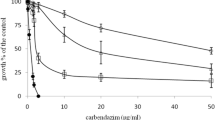Abstract
In total, 404 variants resistant to the antimicrotubule agent benomyl were isolated from UV-irradiated oidia of the basidiomyceteCoprinus cinereus. Part of the variants showed, in addition to benomyl resistance, heat sensitivity or heat dependence. Fifteen variants selected on the basis of different phenotypes were subjected to further analyses. All of the 15 variations were due to single-gene mutations, and the mutations comprised four groups (benA, benB, benC, andbenD) in terms of genetic linkage. Some of the 15 mutations affected nuclear migration in dikaryosis and/or fruiting processes.
Similar content being viewed by others
Literature Cited
Borck K, Braymer HD (1974) The genetic analysis of resistance to benomyl inNeurospora crassa. J Gen Microbiol 85:51–56
Burland TG, Gull K (1984) Molecular and cellular aspects of the interaction of benzimidazole fungicides with tubulin and microtubules. In: Trinci APJ, Ryley JF (eds) Mode of action of antifungal agents. Cambridge, London, New York, New Rochelle, Melbourne, Sydney: Cambridge University Press, pp 299–320
Burland TG, schedl T, Gull K, Dove WF (1984) Genetic analysis of resistance to benzimidazoles inPhysarum: differential expression of β-tubulin genes. Genetics 108:123–141
Kamada T, Hamada Y, Takemaru T (1982) Autolysisin vitro of the stipe cell wall inCoprinus cinereus. J Gen Microbiol 128:1041–1046
Kamada T, Katsuda H, Takemaru T (1984) Temperaturesensitive mutants ofCoprinus cinereus defective in hyphal growth and stipe elongation. Curr Microbiol 11:309–312
Miles PG, Takemaru T, Kimura K (1966) Incompatibility factors in the natural population ofSchizophyllum commune. I. Analysis of the incompatibility factors present in fruit bodies collected within a small area. Bot Mag (Tokyo) 79:693–705
Morris NR (1986) The molecular genetics of microtubule proteins in fungi. Exp Mycol 10:77–82
Raper JR (1966) Genetics of sexuality in higher fungi. New York: Ronald
Roy D, Fantes PA (1982) Benomyl resistants ofSchizosaccharomyces pombe cold sensitive for mitosis. Curr Genet 6:195–201
Uno I, Ishikawa T (1971) Chemical and genetical control of induction of monokaryotic fruiting bodies inCoprinus macrohizus. Molec Gen Genet 113:228–239
Van Tuyl JM (1977) Genetics of fungal resistance to systemic fungicides. Ph.D. Thesis, University of Wageningen, The Netherlands
Yamamoto M (1980) Genetic analysis of resistant mutants to antimitotic benzimidazole compounds inSchizosaccharomyces pombe. Mol Gen Genet 180:231–234
Author information
Authors and Affiliations
Rights and permissions
About this article
Cite this article
Kamada, T., Sumiyoshi, T., Shindo, Y. et al. Isolation and genetic analysis of resistant mutants to the benzimidazole fungicide benomyl inCoprinus cinereus . Current Microbiology 18, 215–218 (1989). https://doi.org/10.1007/BF01570294
Issue Date:
DOI: https://doi.org/10.1007/BF01570294




